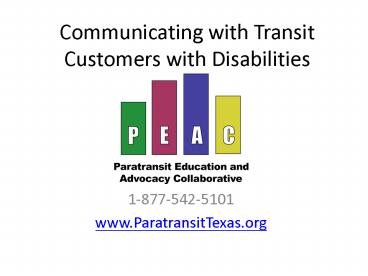Communicating with Transit Customers with Disabilities - PowerPoint PPT Presentation
1 / 16
Title:
Communicating with Transit Customers with Disabilities
Description:
'Person who is deaf or hard of hearing' vs. 'deaf person' or 'hearing impaired' ... Generalized tonic clonic (grand mal) seizures. Complex partial seizures ... – PowerPoint PPT presentation
Number of Views:46
Avg rating:3.0/5.0
Title: Communicating with Transit Customers with Disabilities
1
Communicating with TransitCustomers with
Disabilities
- 1-877-542-5101
- www.ParatransitTexas.org
2
General Guidelines
- The use of People First terminology
- Person who uses a wheelchair vs. wheelchair
user - Person who is deaf or hard of hearing vs. deaf
person or hearing impaired - Seniors or older adults vs. elderly
3
General Guidelines
- Treat customers with disabilities as youd like
to be treated. - Introduce yourself.
- Identify the customers service needs.
- Dont assume a customer has abilities or
inabilities. - Verify the desired destination.
- Ask the customer whether s/he needs assistance.
- Be patient with the customer pace in boarding and
deboarding.
4
General Guidelines
- Dont touch customers without their permission.
- Prefer to speak directly at eye level with
customers with disabilities, not their
companions. - If requested, repeat or write your comments.
- Listen and be courteous.
- Ask customers with difficult speech to repeat
comments until you understand. (Relay Services
at 7-1-1) - Be patient when customers use communication
devices. - To verify, repeat back to customers what you
understand. - Customers with disabilities should have the same
choices as other customers. - Remain professional when addressing problems.
5
Serving Customers who are Deaf or Hard of Hearing
- Alerting the passenger of your arrival to pick
them up - Use accessible door bell (blinking light)
- Relay Services at 7-1-1
- Dont sound your horn
- Face customers directly when speaking to them.
- Speak clearly.
- Dont raise your voice.
6
Serving Customers who use Wheelchairs/Scooters
- Customers who need or want to transfer
know best how to get into the seat. - Mobility devices are part of customers personal
space. Dont lean on them without permission. - Dont assume how mobility devices are stored.
- Canes and walkers are typically stored in
passenger compartment. - Manual wheelchairs are stored in trunk.
- Power chairs scooters are accommodated with
accessible vehicles via lowered floors with ramps
or lifts.
7
Serving Customers who use Service Animals
- Service Animals are allowed by the ADA to ride
with customers. - People with various types of disabilities use
service animals. - Dogs are the most common service animal, but
others can be used. - Some service animals wear ID like a vest, rag or
rigid harness. - If youre unsure whether an animal is a service
animal, ask which service it can perform. - Owner must stay with and control the service
animal at all times. - Dont touch or talk to service animals.
8
Serving Customers with Visual Disabilities
- Identify yourself, and use the customers name if
you know it. - Verify the desired destination.
- Respond verbally to let them know you were
listening. - Ask the customer about the assistance s/he
prefers. - At the drop-off point, give specific directions
to their destination.
9
Serving Customers with Epilepsy
- Epilepsy is a hidden disability.
- An uncomplicated seizure typically is not a
medical emergency, though it may look like one. - Two general types of seizures
- Generalized tonic clonic (grand mal) seizures
- Complex partial seizures
10
Serving Customers with Epilepsy
- Common first-aid tips
- Stay calm and reassure others nearby.
- Dont hold the person down.
- Time the seizure with your watch.
- Dont expect the person to respond to verbal
instruction. - Clear the immediate area of hard or sharp
objects. - Put something flat and soft under the head.
- Dont force his/her mouth open.
- Call 9-1-1 if seizures become violent, or lasts
longer than 5-10 minutes.
11
Serving Customers with Cognitive Disabilities
- Cognitive disabilities are hidden disabilities.
- Customers MAY need assistance with/from
- A companion traveler
- Orientation/awareness of surroundings
- Communication
- Judgments/decisions
- Memory aids
12
Customer Service Summary
- Respect should be mutually shown between you and
the customer. - PEAC offers one-on-one technical assistance to
customers as well as transit providers at
1-877-542-5101. - Podcast trainings
- www.paratransittexas.org/presentations
- ADA Paratransit General Guidelines
- ADA Paratransit Eligibility
- Self-Advocacy Tools for Customers
- An Overview of Travel Training
13
Other Resources
- Easter Seals Project Action
- www.projectaction.easterseals.com
- (800) 659-6428
- American Council of the Blind
- www.acb.org
- (800) 424-8666
- Epilepsy Foundation
- www.epilepsyfoundation.org
- (800) 332 1000
- United Cerebral Palsy
- www.ucp.org
- (800) 872-5827
- American Public Transportation Association
- www.apta.com
- (202) 496-4800
- Federal Transit Administration
- www.fta.dot.gov/civil_rights.html
- (866) 525-5561
14
Dan GadburyProject Manager 1300 Circle
DriveFort Worth, Texas 76119cell
817.800.7215office 817.569.4045fax
817.569.5474dan.gadbury_at_mhmrtc.org
15
Kristy RangeEast Texas Outreach Coordinator
4700 Guadalupe, Suite A409Austin, TX 78751
cell 903-714-5079toll free 1.877.542.5101krist
y_at_peactexas.org
16
Sheila Holbrook-WhiteExecutive DirectorTexas
Citizen Fund4700 Guadalupe, Suite A409Austin,
TX 78751cell 512.699.8136toll free
1.877.542.5101fax 512.451.3578scouttxca_at_gmail.c
om































